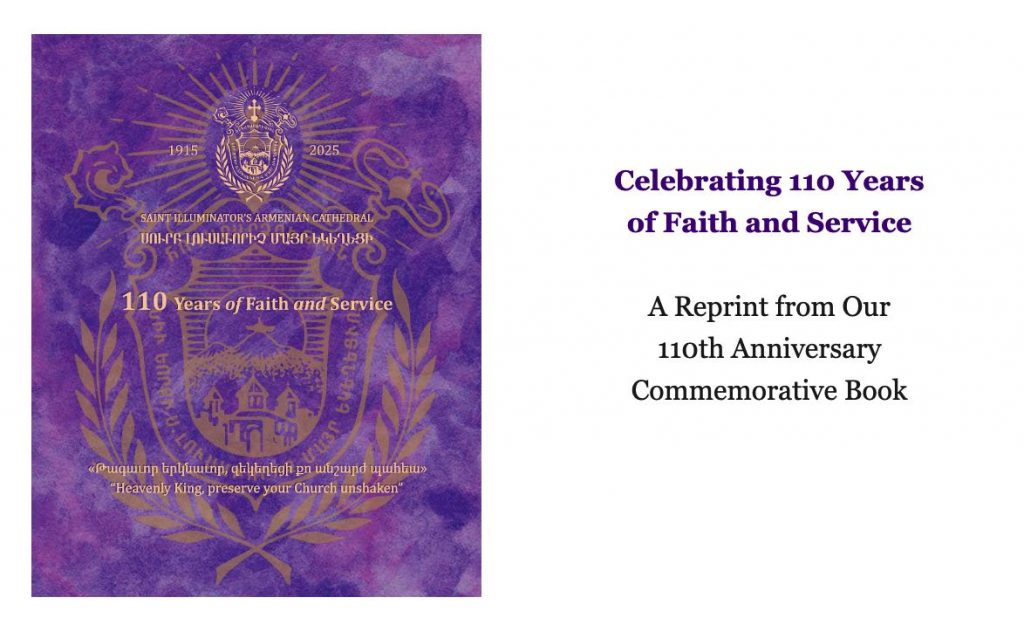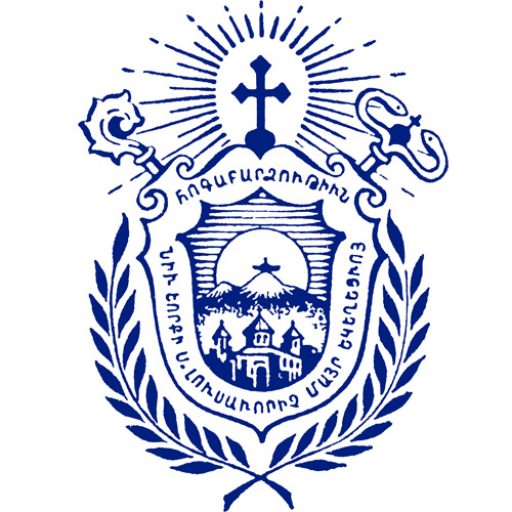
A Man for All Seasons: Rev. Fr. Mesrob Lakissian
An Appreciation
By Lucine Kasbarian
The novelist Raffi, perhaps the most influential figure in 19th century Armenian literature, once said: “We have never had a prosperous clergy. We have only had a few revered churchmen.”
Der Mesrob is one such churchman.
And like so many self-sacrificing churchmen who have passed through the portals of St. Illuminator’s before him, for the glory of God, Der Mesrob has, in word and deed, inspired and reinforced the conviction in his people to maintain, advance—and even at times re-
store—their attachment to their Christian Armenian identity.
During his ordination year of 2005, following Der Mesrob’s first or second Soorp Badarak as pastor, I said to him as I approached the Altar to venerate the Asdvadzashoonch, “You are the right man at the right place at the right time.” Today, the 20 years of Der Mesrob’s ministry stands as a vindication of that sentiment, and I repeat it with even deeper conviction. Der Mesrob does justice to the spirit of our Mayr Yegeghetsi which began her history as a welcoming beacon of hope and renewal to exiles after the Armenian Genocide and upholds the Cathedral’s contemporary position as spiritual and cultural touchpoint for the descendants of those generations of Armenians and those entirely new to her family.
A native son of Anjar, Lebanon, Der Mesrob comes from an Armenian family of lawmakers and educators of courageous Musa Daghtsi ancestry. Upon the invitation of H. E. Archbishop Mesrob Ashjian, of blessed memory, Der Mesrob arrived in the United States in the early 1990s and first went to work as the manager of the Armenian Prelacy’s bookstore in Manhattan. It was during that time, while interning at the Prelacy, that I met him. Back then, he was known by his baptismal name, Krikor, but we called him “Koko” for short. His ability to relate to people of all ages and persuasions was immediately evident. His friendliness, honesty, high energy, generous nature and inherent leadership skills made him a magnetic personality.
“You are the right man
at the right place at
the right time.”
— Lucine Kasbarian
Der Mesrob was ordained at St. Illuminator’s Cathedral on November 20, 2005 by H. E. Archbishop Oshagan Choloyan. Richard Sarajian was his “Gnkahayr,” which means Godfather. Armenian Christian tradition calls newly ordained priests to assume a new name upon ordination. Der Mesrob chose the name Mesrob for three reasons. First, he wished to pay homage to St. Mesrob Mashdots, inventor of the Armenian alphabet, godfather of our literary tradition, and one of Armenia’s patron saints, the 1,600th anniversary of whose birth was, at that time, upon us. Second, he wished to honor his patron and mentor, Archbishop Mesrob Ashjian. And third, he wished to channel his own love for and dedication to Armenian literature by invoking Mesrob’s name.
Der Mesrob graduated from the Zarehian Armenian Theological Seminary of the Catholicosate of Cilicia, at Bikfaya, Lebanon, in 1990. In New York, he attended Queens College in New York; taught Armenian history, language, and religion at St. Illuminator’s Day School and St. Sarkis’ Saturday School; and spent three years as principal of the Prelacy’s Siamanto Academy. He also served fifteen years as a deacon on the Altar of our Cathedral.
These assignments and experiences before his ordination, together with his 20 years of pastoral service at St. Illuminator’s, reveal how Der Mesrob is indeed a man for all seasons—capable of taking on many directives so essential to the perpetuation of the Armenian identity, and succeeding at every turn.
 Then-Deacon Krikor with his beloved parents, Diramayr Isgouhi and Bedros Lakissian, of blessed memory, at the Catholicosate on the day of his ordination as a deacon, Antelias, June 1987.
Then-Deacon Krikor with his beloved parents, Diramayr Isgouhi and Bedros Lakissian, of blessed memory, at the Catholicosate on the day of his ordination as a deacon, Antelias, June 1987.
Appropriate for the worldly position one must fill as the pastor of a metropolitan and cosmopolitan parish, Der Mesrob comfortably wears many hats: Clergyman, cultural ambassador, educator, administrator, fundraiser, activist, guidance counselor, diplomat and negotiator, champion of youth, and above all, Hoviv, Shepherd. In addition to celebrating the Divine Liturgy and performing the sacraments, Der Mesrob is responsible for organizing and is present at nearly every spiritual, educational or cultural event sponsored by the Cathedral. He also routinely visits hospitals and nursing homes, delivers meals to elderly parishioners, escorts the infirm to see physicians, keeps a watchful eye on our elders, and selflessly and discreetly performs acts of goodness, service and grace too numerous to count, for which he neither seeks nor receives the recognition he deserves. As comfortable introducing cultural programs or leading public demonstrations as he is in the pulpit, his sermons and speeches not only speak to us as Armenians and Christians, they contain something meaningful and relevant to our everyday lives.
It was also because of Der Mesrob’s foresight and under his watchful eye that the necessary and overdue structural renovation of St. Illuminator’s Cathedral took place. Thus, Der Mesrob tended not just to the spiritual, cultural, and social nourishment of the Church community in his charge, but to the decidedly temporal restoration of the house it occupied.
Then-Deacon Krikor in his dormitory room, final year at the Zarehian seminary, 1990.

In addition, Der Mesrob also singlehandedly raised the profile of St. Illuminator’s through his outreach to Armenian schools from far away communities who now include the Cathedral among their whistlestops when they tour Manhattan. Indeed, Der Mesrob is at the nexus of the special energy that guests describe upon visiting St. Illuminator’s Cathedral, a wholly Armenian sanctuary that, in the words of H. H. Catholicos Aram I, is “draped with faith and paved with love.”
We all owe a debt of gratitude to Der Mesrob not only for lovingly shepherding his flock. We thank him for the existence of our Cathedral’s benevolent fund—a fund which has secured the Cathedral’s finances and enabled the St. Illuminator’s to do charitable work through financial gift-giving to Armenians in need in Armenia, Artsakh, Lebanon and Syria and to Armenian causes here at home.
Eloquently summed up by Board of Trustees Chair Armen Morian, “The fund is our providential reward for the uncommonly attentive ministry of our very own Der Mesrob, whose tireless labors have built an institution that has attracted the attention, captured the imagination and earned the trust of benefactors who have given so generously to the Cathedral.”
 Vodûnlva at St. Gregory the Illuminator Cathedral by H. H. Karekin II, Antelias, 1990.
Vodûnlva at St. Gregory the Illuminator Cathedral by H. H. Karekin II, Antelias, 1990.

Der Mesrob at his ordination, with Richard Sarajian, his Godfather, and Diramayr Isgouhi, of blessed memory, November 20, 2005.
As Der Mesrob himself has often said, “being a priest is not a 9-to-5 job.” It is also not one that is performed solo. To everyone’s good fortune, Der Mesrob has had a solid support system behind him, beginning with our beloved Prelate, H. E. Archbishop Anoushavan Tanielian, the Cathedral’s Board of Trustees, Altar servers, choirmaster and organist, the Ladies Guild, Saturday and Sunday School faculty, the Cathedral staff, pro bono attorney and other volunteers, all the way to the Armenia Religious Educational Council, The Armenian National Education Committee, Prela cy staff and of course the Cathedral parishioners, benefactors, supporters and friends. Der Mesrob is also blessed with his devoted wife, Yeretsgeen Ojeen, their energetic daughter Taleen, and his steadfast sister Tamar, all who stand behind and support Der Mesrob in his ministry and selflessly serve the Church, body and soul, quite visibly as well as behind the scenes.

Der Mesrob at his ordination, with H. E. Archbishop Oshagan Choloyan and then-Very Rev. Fr., now-Archbishop Anoushavan Tanielian, his sponsor.
Like a true leader, Der Mesrob does not lead by directive, he leads by example. He sets a vision, then guides and inspires by his own hard work. Above all, he has a keen eye to see those who give of themselves to serve; expresses appreciation and gratitude for their service, and assures that all who have earned it receive the recognition they deserve. He shines the spotlight on all, celebrating that each person has unique gifts to share with the parish and the world.
Our parish may be a modest one in size and number, but under Der Mesrob’s leadership, the St. Illuminator’s community turns the rhetoric of Christian charity into concrete action and makes an outsized difference in the lives of Armenians in New York and beyond than the scale of the institution he leads.
“Der Mesrob reminds us why
the Armenian Church has been
the standard-bearer of national values,
the vessel of national identity,
and mother protector of both,
ever since 301 A.D.”
— Lucine Kasbarian
Throughout its history as a captive nation, Armenia and its people have, time and again, turned to their Church and clergy for not just spiritual, moral and communal guidance but even political representation, advocacy, negotiation, arbitration and adjudication in times of repression. And the Armenian Church, in turn, has assumed by necessity, the role of leading the Armenian people, se-curing their safety and rights from hostile imperial rulers, and preserving Christian Armenian identity. In that very same tradition, Der Mesrob does far more than an average churchman. His fulfillment of his sacred obligations to his “frock and flock” explains why he so aptly carries out his duties with the trust, love and support of his parishioners. His vocation and avocation are one and the same.

Ordination day, with Yeretsgeen Ojeen and baby Taleen.
The Lakissian Family, 2024.

By repeating the sacred traditions that have sustained the Armenian people for centuries, Der Mesrob reminds us why the Armenian Church has been the standard-bearer of national values, the vessel of national identity, and mother protector of both, ever since 301 A.D.—and especially during the more than 700 years of foreign occupation and turmoil.\
As the Armenian homeland again faces existential threats as tens of thousands of Armenians today continue to face fractured existences on native lands as well as in exile, and as Armenians in the Diaspora face the forces of cultural assimilation and nihilism, that role is as important as ever. Der Mesrob stands on the front line, and that stewardship fulfills those very same needs now—in the highest and best tradition of the Armenian Church.
“So he shepherded them according to the integrity of his heart, and guided them with his skillful hands.” — Psalms 78:72
